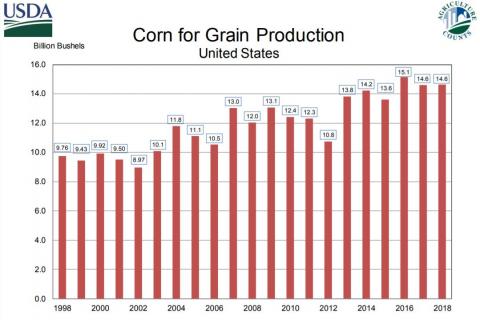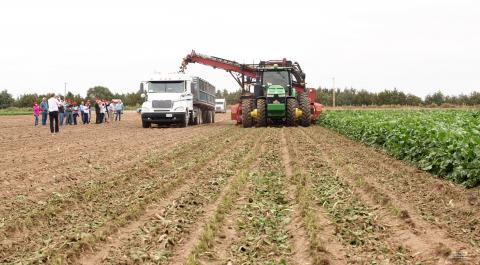USDA Forecasts Record Nebraska Corn Harvest
September 12, 2019
Based on September 1 conditions, Nebraska's 2019 corn crop is forecast at a record 1.79 billion bushels, up slightly from last year's production. Soybean production is forecast at 287 million bushels, down 14% from last year. See forecasts for sorghum, surgar beets and dry beans too.
Cercospora Leaf Spot Spotted in the Panhandle – Be Aware!
July 15, 2019
On July 15 symptoms characteristic of cercospora leaf spot were observed on the lower leaves of sugar beets at the university’s Panhandle Research and Extension Center in Scottsbluff. While it is unusually early for this disease, growers are urged to scout their fields as fungicide applications may be necessary.
USDA Reports NE Corn and Soybean Production Hit Record Highs
February 8, 2019
Corn for grain production and soybean set record highs in 2018, according to the end-of-year report from USDA. See how all major crops in Nebraska fared.
Specialty Crops Disease Update
January 10, 2019
The occurrence and distribution of plant pathogens are long known to be strongly influenced by the environment. We see evidence of this concept every season on specialty crops in western Nebraska, and 2018 was no exception.
Sugar Beet Harvest Finishes Well
November 27, 2018
It was a good sugar beet harvest in the Nebraska Panhandle and now beets are being processed. Nebraska ranks fifth in the nation in sugar beet production
USDA Forecasts Record Nebraska Corn and Soybean Yield and Production
November 8, 2018
Based on November 1 conditions, Nebraska's 2018 corn crop is forecast at 1.80 billion bushels, up 7% from last year's production. Soybean production is forecast at 345 million bushels, up 6% from last year.
Foreign Ag Representatives View Nebraska Farms First-Hand
September 27, 2018
A group of 27 foreign agriculture attachés from 23 countries recently visited several ag production sites in Nebraska, including a farm near Morrill where sugarbeet harvest was underway.
Corn and Soybean Forecast for Record Yields, Production
September 12, 2018
USDA forecasts record yields for Nebraska corn, soybean, sorghum and sugarbeet and record production for corn and soybean. Nationally, corn is forecast up 2% from 2017 and soybean, up 7%.




